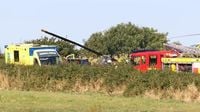A tragic helicopter crash on the Isle of Wight has left three people dead and a fourth in critical condition, sending shockwaves through the local community and raising urgent questions about aviation safety in flight training. The incident, which unfolded on the morning of August 25, 2025, involved a Robinson R44 II helicopter operated by Northumbria Helicopters during a routine flying lesson. The aircraft had departed Sandown Airport at approximately 9 a.m., carrying four people including the pilot, and was en route over the picturesque landscape near Shanklin and Ventnor when disaster struck.
According to reports from the BBC, The Guardian, Sky News, and the Isle of Wight County Press, the helicopter reached an altitude of about 800 feet before it began to spiral out of control. One local witness, speaking to the Isle of Wight County Press, described the harrowing moments before the crash: "The helicopter could be seen 'spiralling' in the air before it crashed into a hedge." She added that she was the first person on the scene and saw four people on board, believing that the airbags had been activated.
The crash occurred near the A3020 Shanklin Road, close to the town of Ventnor, at around 9:20 a.m. local time. Emergency services responded rapidly, with a multi-agency team that included the Hampshire & Isle of Wight Fire & Rescue Service, Hampshire and Isle of Wight Air Ambulance, and the Air Accidents Investigation Branch (AAIB). The road near the crash site was closed to allow emergency vehicles access, and authorities urged the public to avoid the area.
The Hampshire and Isle of Wight Constabulary confirmed the three fatalities and stated that a fourth person was seriously injured. The injured individual was treated at the scene by a critical care team consisting of a doctor and a specialist paramedic, before being airlifted to the Major Trauma Centre at University Hospital Southampton at approximately 11:40 a.m. The Hampshire and Isle of Wight Air Ambulance team expressed their condolences, stating, "Our thoughts are with them and everyone involved in today’s incident."
Northumbria Helicopters, the operator of the ill-fated aircraft, confirmed that the helicopter involved was the G-OCLV model, listed as a Robinson R44 II. In a statement, a spokesperson said, "Northumbria Helicopters confirms aircraft G-OCLV was involved in an accident in the Shanklin area on the Isle of Wight. The flight, which departed from Sandown Airport at approximately 9am, was carrying four passengers on board including the pilot, and was undertaking a flying lesson. Northumbria Helicopters is giving its full co-operation to the authorities investigating this incident." The company, according to the Associated Press, is cooperating fully with investigators.
The UK’s Air Accidents Investigation Branch wasted no time in launching a probe into the crash. In a statement posted on its website, the AAIB confirmed, "A team of inspectors has been sent to the accident site to gather evidence and make enquiries." The investigation will focus on determining the cause of the crash, examining factors such as mechanical failure, pilot error, weather conditions, and flight procedures.
As news of the tragedy broke, the Isle of Wight community was left reeling. Joe Robertson, the Member of Parliament for Isle of Wight East, shared his sympathies on social media: "My heart goes out to the families of those who lost their lives in the helicopter crash outside Shanklin today. It is very sad and tragic news during what should have been a happy bank holiday helicopter flight from Sandown Airport. The whole community is in shock. My sincere thanks to all the emergency services personnel who have been involved and to the investigators for their work ahead."
Authorities have so far withheld the identities of those involved, citing privacy concerns and the need to notify families. The Hampshire and Isle of Wight Constabulary reiterated that they had no additional information to share about the victims or the circumstances that led to the crash at this stage.
This incident has cast a somber light on the inherent risks associated with aviation training, particularly in small aircraft such as the Robinson R44 II. According to Devdiscourse, while flight training is generally safe, the complexity and unpredictability of helicopter flight can present unique challenges, especially for trainees and instructors alike. The Robinson R44 II, a popular light helicopter used globally for training and private flights, has a generally solid safety record, but like all aircraft, is not immune to mechanical or operational issues.
In the immediate aftermath of the crash, the local community and the wider aviation sector have been left searching for answers. The AAIB’s investigation is expected to be thorough, with inspectors gathering flight data, maintenance records, and eyewitness accounts. The hope is that their findings will not only explain what went wrong but also offer recommendations to prevent similar tragedies in the future.
Meanwhile, the response from emergency services has been widely praised. The swift arrival of the Hampshire and Isle of Wight Air Ambulance, along with the coordinated efforts of fire, rescue, and police teams, ensured that the injured survivor received critical care as quickly as possible. As the AAIB’s work continues, the local authorities have stood down the major incident status but remain vigilant as the investigation unfolds.
For many on the Isle of Wight, the crash is a stark reminder of how quickly routine activities can turn catastrophic. The loss of three lives during what should have been a routine flying lesson has left an indelible mark on the island’s close-knit community. As tributes pour in and investigators sift through the wreckage, the hope is that answers will emerge and, in time, that the lessons learned will make future flights safer for everyone.
With the investigation ongoing, the thoughts of residents, officials, and the aviation world remain with the victims and their families, who face unimaginable loss in the wake of this tragic event.


